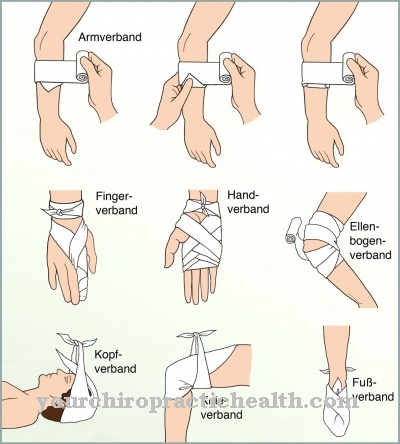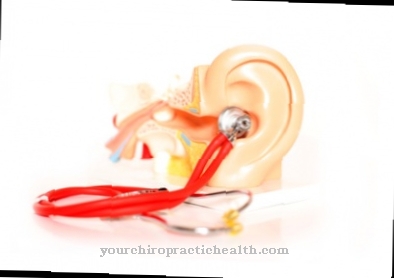If the normal ECG, stress ECG and cardiac ultrasound examination (echocardiography) result in unclear heart findings, but no precise diagnosis can be made, this is Myocardial scintigraphy the method of choice. It is non-invasive and has a high informative value.
What is myocardial scintigraphy?

The myocardial scintigraphy is a gentle, nuclear medical diagnostic procedure to examine the blood flow, the metabolism and the mass of the heart muscle. The examination of the heart is carried out in two phases: under stress and at rest.
The findings are then compared with one another. In the scintigram, the doctor can see how circulatory disorders affect the heart muscle. The cause of the disturbed blood flow is usually the narrowing of the coronary arteries. Insufficient blood flow to the heart carries the risk of a life-threatening heart attack. The myocardial scintigraphy can determine whether the extent of the circulatory disturbance makes a cardiac catheter examination necessary and can even save some patients from having to do so.
Function, effect & goals
With myocardial scintigraphy, the doctor can see how much blood reaches the heart at rest and under stress. By comparing the recordings, he can determine whether different areas of the heart are supplied with less blood than others under stress. Reduced blood flow could be a sign of vasoconstriction and an increased risk of a heart attack.
If the patient has already had a heart attack, the size of the scar, the extent of the tissue damage and the residual blood flow in the infarct area can be determined. The result determines whether bypass surgery or a stent needs to be placed. In addition to these questions, myocardial scintigraphy provides information about the pumping capacity of the heart and the physical resilience of the patient, which is worse after a heart attack than with healthy, well-perfused tissue.
For the myocardial scintigraphy, an access is made to the arm vein, through which a slightly radioactive carrier substance can be injected during the stress test on the bicycle ergometer, which makes the heart vessels visible. For patients who are physically limited, e.g. B. due to orthopedic problems or if the blood pressure is already too high at rest, there is the possibility of administering a medication to exercise while lying down.
The stress test is checked by a doctor and monitored by an EKG. In the phase of increased exposure, a radioactively enriched carrier substance is injected via the access. The exercise is followed by a period of rest of 30 to 60 minutes, during which the patient should eat a meal that they have brought with them and that is as fatty as possible. After the rest phase, recordings are made with the gamma camera for approx. 20 minutes while lying down and evaluated. These recordings are used to decide whether a resting examination is still required.
Sometimes the stress test is enough. If a resting examination is required for clarification, the radioactivity in the heart must first be broken down for about 2 hours before the second part of the examination follows. Then the same process follows again, only with no load.
Myocardial scintigraphy is always useful to rule out coronary heart disease (CHD) if the following risk factors are still present:
- high blood pressure
- Smoke
- Obesity
- Diabetes mellitus
- increased cholesterol
- family disposition to heart diseases
- Angina pectoris
- Abnormalities in the EKG
Because myocardial scintigraphy determines the extent of the circulatory disorder, it can help optimize treatment and avoid unnecessary surgical interventions. After successful treatments, it can be used as a non-invasive method to control new vasoconstriction. It can also determine an individual heart risk. The examination is offered by all statutory and private health insurance companies as a standard service.
Risks, side effects & dangers
Side effects such as allergies rarely occur with radioactive substances, rather with x-ray examinations as a reaction to contrast media. The radiation exposure is only low and is not higher than with X-rays. However, a very low cancer risk as a long-term consequence cannot be completely ruled out. Therefore, the benefits and risks should always be weighed individually.
The stress phase rarely leads to complications, even in heart disease patients. In order to be able to guarantee an optimal informative value of the examination result, the patient has to reach the highest possible level. In extremely rare cases, this can lead to cardiac arrhythmias and a heart attack. Occasionally, mild side effects such as tightness of the chest, a feeling of warmth, shortness of breath, a feeling of pressure in the abdomen, headache, arm and leg discomfort and dizziness may occur. However, these only occur when the patient is exposed to medication. The radioactive substance itself does not cause any side effects.
During pregnancy, myocardial scintigraphy is only performed in exceptional cases; while breastfeeding, mothers have to pause breastfeeding for two days after the examination. In the case of severe organ diseases, the stress on the cardiovascular system can be too high. Further contraindications are febrile infections, an acute heart attack or severe cardiac insufficiency, uncontrollable high blood pressure, serious cardiac arrhythmias and valve defects, and acute myocardial inflammation (myocarditis).
For the examination, patients must be on an empty stomach for at least 12 hours and only drink a little carbonated water. Medication may be taken, but heart medication should be suspended for 24 hours, and beta blockers even for 2 to 3 days. They can be taken before the resting phase if necessary. Diabetics are allowed to eat a small meal that is as low in fat as possible.













.jpg)

.jpg)
.jpg)











.jpg)